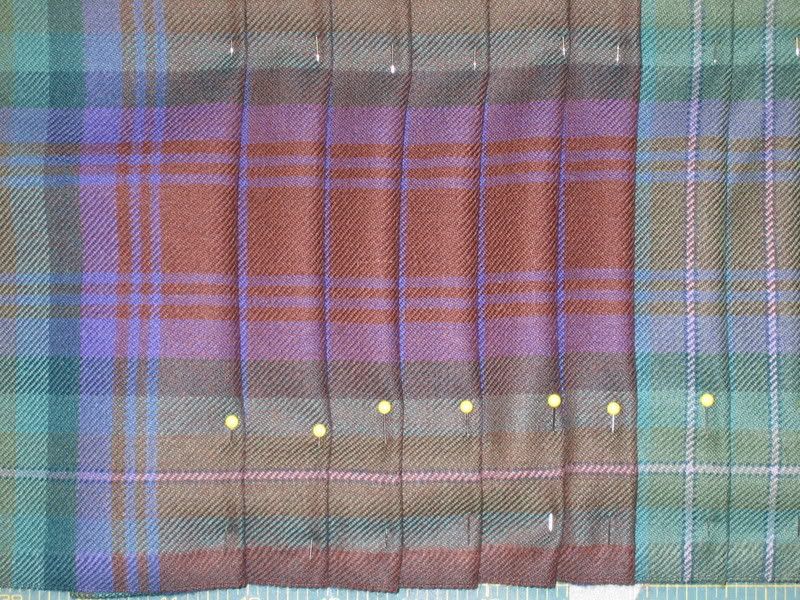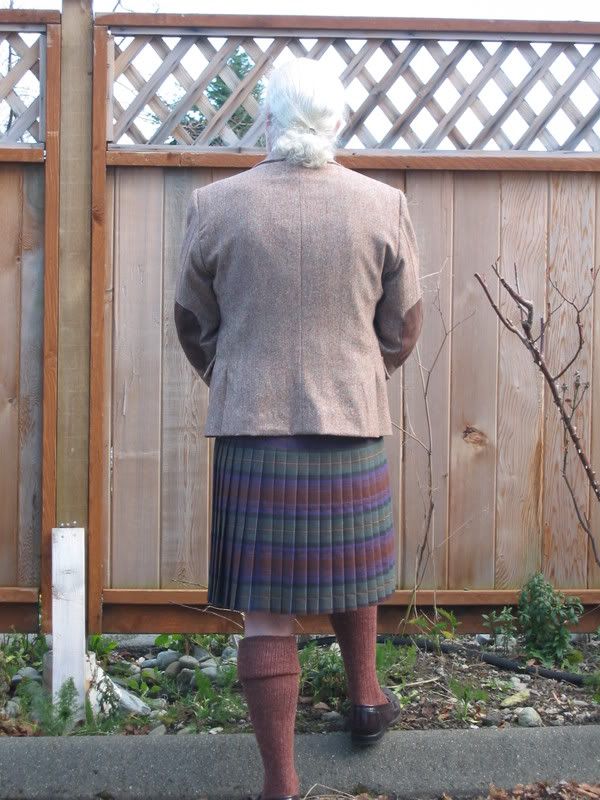|
-
28th January 11, 11:17 AM
#1
 Pleating to Horizontal ?! Pleating to Horizontal ?!
Someone please enlighten me. In Dr. Nicholas J. Fiddes' excellent e-book (for beginners like me) available on the Scotweb home page, he writes,
"A third even rarer method of pleating, ‘to horizontal’, involves choosing a point in the sett for the folds that creates the illusion of a series of strong horizontal bands across the rear. Only a true master of kiltmaking is likely to accomplish this successfully, so do not ask it of a novice. But anyway, it is arguably rare for a reason, as many find it less flattering or aesthetically pleasing."
I know about pleating to sett and stripe, but what exactly is being described here, and why do many find it less pleasing?
My kilt is pleated to a particular stripe and creates a horizontal-band pattern on the pleats. Why wouldn't it be described as pleated "to horizontal"? I see lots of kilts like it and they look good to me!
- Puzzled in Bamburgh
I changed my signature. The old one was too ridiculous.
-
-
28th January 11, 11:57 AM
#2
Around here this is usually called pleating to the block or solid colour. Without a noticeable vertical stripe as you have on your kilt, the horizontal stripes are all that can be seen in the pleats. it is less desirable for the same reason that horizontal stripes are generally undesirable in clothing. A strong vertical stripe in the centre of each pleat can reduce the ... uhm .. 'fat ***' impression that block pleating can leave.
-
-
28th January 11, 12:03 PM
#3
One of the problems we have in kilt making is that everyone seems to use their own words to describe the same thing. There is not an accepted single term for stuff.
Maybe it would be helpful if I describe what this "to the Horizontal" is.
If you look at any Tartan you can easily see the horizontal and vertical stripes. Now look at the spaces between the stripes.
If you were to pleat your Tartan to any prominent vertical stripe the effect when pleated has a strong vertical look. This is what we normally call "To the Stripe"
But now, look at your Tartan again and find an area where there is no strong or prominent vertical element. If you were to use this area for your pleats you would do the pleating in the same way that you would for "To the Stripe" but the end result would look totally different to your eye.
Another kilt maker I know calls this "Pleating to No Stripe"
The best example I can give you is by using the Isle of Skye Tartan.

This Tartan has only one really good vertical element for "Pleating to the Stripe" This is the Green band with the white stripe.

This Tartan can be pleated to the area of the blue and brown stripes but the effect is less pleasing to most eyes. The overall effect is still vertical though.

But what if you look at the brown band and treat it like a stripe even if there is "No Stripe".

I think you can now see that the overall effect is no longer vertical. This is "Pleating to the Horizontal".
Rocky of USA Kilts once called this "The Dread Lawnchair Effect".
Here is a Kilt in Isle of Skye "Pleated to No Stripe" or "Pleated to the Horizontal".

I think you can see that the overall effect is primarily horizontal. The Isle of Skye Tartan is one of the few that can be pleated like this and not look, how shall I say this, off.
Ask any lady. They will tell you that Vertical stripes are slimming, Horizontal stripes,,,well, not.
So when ever I put on my Isle of Skye kilt I stand in front of the mirror and say "Hey, honey, do these pleats make my butt look fat?"
Last edited by The Wizard of BC; 28th January 11 at 12:19 PM.
Steve Ashton
www.freedomkilts.com
Skype (webcam enabled) thewizardofbc
I wear the kilt because: Swish + Swagger = Swoon.
-
-
28th January 11, 12:41 PM
#4
 Originally Posted by xman

A strong vertical stripe in the centre of each pleat can reduce the ... uhm .. 'fat ***' impression that block pleating can leave.
A very important point for my brother who is the above OP, and explains his preference for "Numquam ubi, sub ubi"! 
-
-
28th January 11, 12:44 PM
#5
-
-
28th January 11, 12:56 PM
#6
I actually requested my kilt to be pleated this way on purpose. Not necessarily to show off horizontal stripes, but so that there would be more 'flash' of color when the pleats swish. I wanted to see more of the blue color on the pleats when standing, and only see a lot of green when walking.
Yes, some call it the 'lawnchair effect', but I don't think it looks bad.

-
-
28th January 11, 01:09 PM
#7
Pay no attention to jose995. He's an impostor of the 1st order! ;-)
xman: Thanks. I get the point about horizontal lines - they make you appear "broader in the beam", so to speak.
Wizard of BC: Thanks for the detailed and thorough reply, especially the pictures. It has been most helpful. The light bulb has come on, but I need to think about it a bit more to fully appreciate the differences.
The conclusion I am drawing is that visual, vertical elements present in the pleating reduce the "broad-beam" effect produced by the inevitable horizontal elements. Even your "Isle of Skye" kilt, which I must say is most handsome, has vertical visual elements - the knife edges of the pleats themselves.
Please let me know if I'm incorrect about any of this.
I changed my signature. The old one was too ridiculous.
-
-
28th January 11, 01:20 PM
#8
David,
Thanks for the pointer to the older thread on this subject, but I'm glad I didn't see it before I read the reply from Wizard of BC. I would have been even more confused!
Incidentally, I had to guess at the shipping charge. Let me know if it's insufficient.
I changed my signature. The old one was too ridiculous.
-
-
28th January 11, 01:35 PM
#9
Tobus: I like the horizontal "lawn-chair" effect, too, despite its presumed, and even perceived, effect on the extent of the nether regions. Also, I have seen the flash you described on kilts in which the wearer was briskly walking. It looks very dynamic and colorful.
My kilt is pleated to a vertical white stripe, and has lots of broad horizontal bands that dominate the backside view. It looks good to me. I would post a picture, but I just read how to do it. I need to find a web server on which to store my photos.
I changed my signature. The old one was too ridiculous.
-
-
28th January 11, 03:13 PM
#10
I have no idea why the original item that you read said that it is a method not to be tackled by novice kiltmakers. It is actually THE EASIEST way to pleat a kilt. Because a pleat is all one color, the only precision you have to worry about is lining up the horizontal stripes. There's nothing at all to worry about in the pleat itself - no central element to keep centered, no edge stripe to keep on an edge. And layout is really easy. When I have a novice kiltmaker, and the tartan is appropriate, I commonly suggest doig a first kilt this way because it is so easy.
This kind of pleating works best with a tartan that isn't too "stripey" and has subdued color differences. For those tartans, it really doesn't make someone look broad in the beam. Here's an example with the Ancient Douglas:

-
Similar Threads
-
By Barb T in forum Hint and tips from Barb T.
Replies: 14
Last Post: 17th June 09, 06:13 AM
-
By TheKiltedCoder in forum DIY Showroom
Replies: 2
Last Post: 13th June 08, 12:51 PM
-
By keepoffgrass in forum Professional Kiltmakers Hints and Tips
Replies: 7
Last Post: 9th June 08, 04:20 PM
-
By michael steinrok in forum General Kilt Talk
Replies: 23
Last Post: 30th April 07, 09:35 AM
-
By Barb T in forum Traditional Kilt Wear
Replies: 14
Last Post: 3rd December 04, 12:19 PM
Tags for this Thread
 Posting Permissions
Posting Permissions
- You may not post new threads
- You may not post replies
- You may not post attachments
- You may not edit your posts
-
Forum Rules
|
|





























Bookmarks